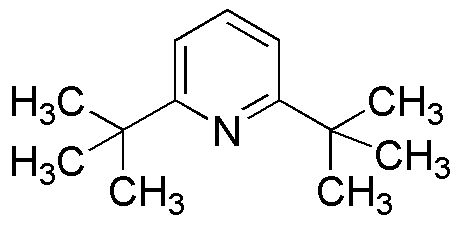2,6-Di-tert-butylpyridine is widely utilized in research focused on:
- Antioxidant Applications: This compound is effective in preventing oxidative damage in various materials, making it valuable in the production of plastics and rubber, where it enhances longevity and performance.
- Catalysis: It serves as a ligand in catalytic processes, particularly in organic synthesis, improving reaction efficiency and selectivity in the pharmaceutical industry.
- Corrosion Inhibition: Used in coatings and treatments, it helps protect metals from corrosion, which is crucial in industries like automotive and construction.
- Pharmaceutical Development: Its properties are leveraged in drug formulation, particularly for stabilizing active ingredients and enhancing bioavailability.
- Research in Material Science: The compound is studied for its role in developing new materials with enhanced thermal and chemical stability, beneficial in electronics and aerospace applications.
General Information
Properties
Safety and Regulations
Applications
2,6-Di-tert-butylpyridine is widely utilized in research focused on:
- Antioxidant Applications: This compound is effective in preventing oxidative damage in various materials, making it valuable in the production of plastics and rubber, where it enhances longevity and performance.
- Catalysis: It serves as a ligand in catalytic processes, particularly in organic synthesis, improving reaction efficiency and selectivity in the pharmaceutical industry.
- Corrosion Inhibition: Used in coatings and treatments, it helps protect metals from corrosion, which is crucial in industries like automotive and construction.
- Pharmaceutical Development: Its properties are leveraged in drug formulation, particularly for stabilizing active ingredients and enhancing bioavailability.
- Research in Material Science: The compound is studied for its role in developing new materials with enhanced thermal and chemical stability, beneficial in electronics and aerospace applications.
Documents
Safety Data Sheets (SDS)
The SDS provides comprehensive safety information on handling, storage, and disposal of the product.
Product Specification (PS)
The PS provides a comprehensive breakdown of the product’s properties, including chemical composition, physical state, purity, and storage requirements. It also details acceptable quality ranges and the product's intended applications.
Certificates of Analysis (COA)
Search for Certificates of Analysis (COA) by entering the products Lot Number. Lot and Batch Numbers can be found on a product’s label following the words ‘Lot’ or ‘Batch’.
Número de catálogo
Número de lote/lote
Certificates Of Origin (COO)
This COO confirms the country where the product was manufactured, and also details the materials and components used in it and whether it is derived from natural, synthetic, or other specific sources. This certificate may be required for customs, trade, and regulatory compliance.
Número de catálogo
Número de lote/lote
Safety Data Sheets (SDS)
The SDS provides comprehensive safety information on handling, storage, and disposal of the product.
DownloadProduct Specification (PS)
The PS provides a comprehensive breakdown of the product’s properties, including chemical composition, physical state, purity, and storage requirements. It also details acceptable quality ranges and the product's intended applications.
DownloadCertificates of Analysis (COA)
Search for Certificates of Analysis (COA) by entering the products Lot Number. Lot and Batch Numbers can be found on a product’s label following the words ‘Lot’ or ‘Batch’.
Número de catálogo
Número de lote/lote
Certificates Of Origin (COO)
This COO confirms the country where the product was manufactured, and also details the materials and components used in it and whether it is derived from natural, synthetic, or other specific sources. This certificate may be required for customs, trade, and regulatory compliance.


